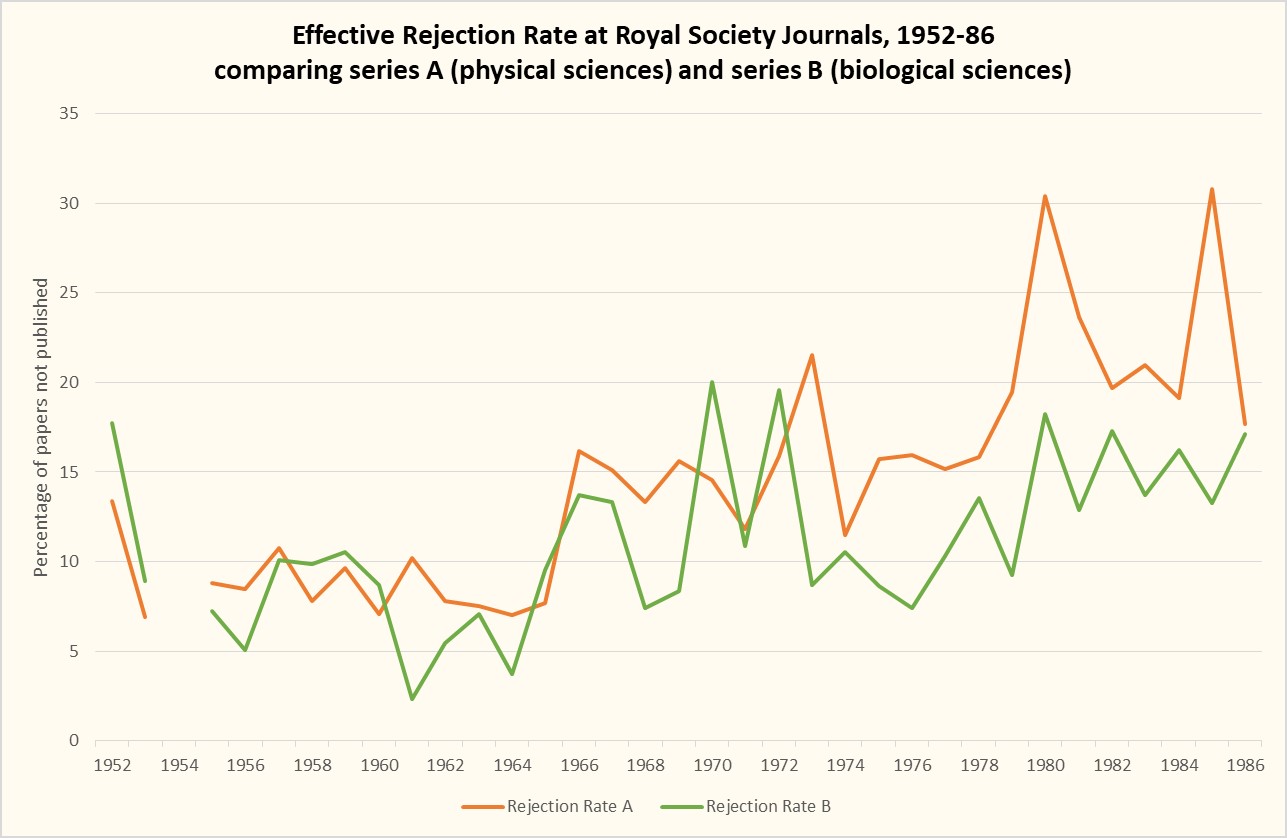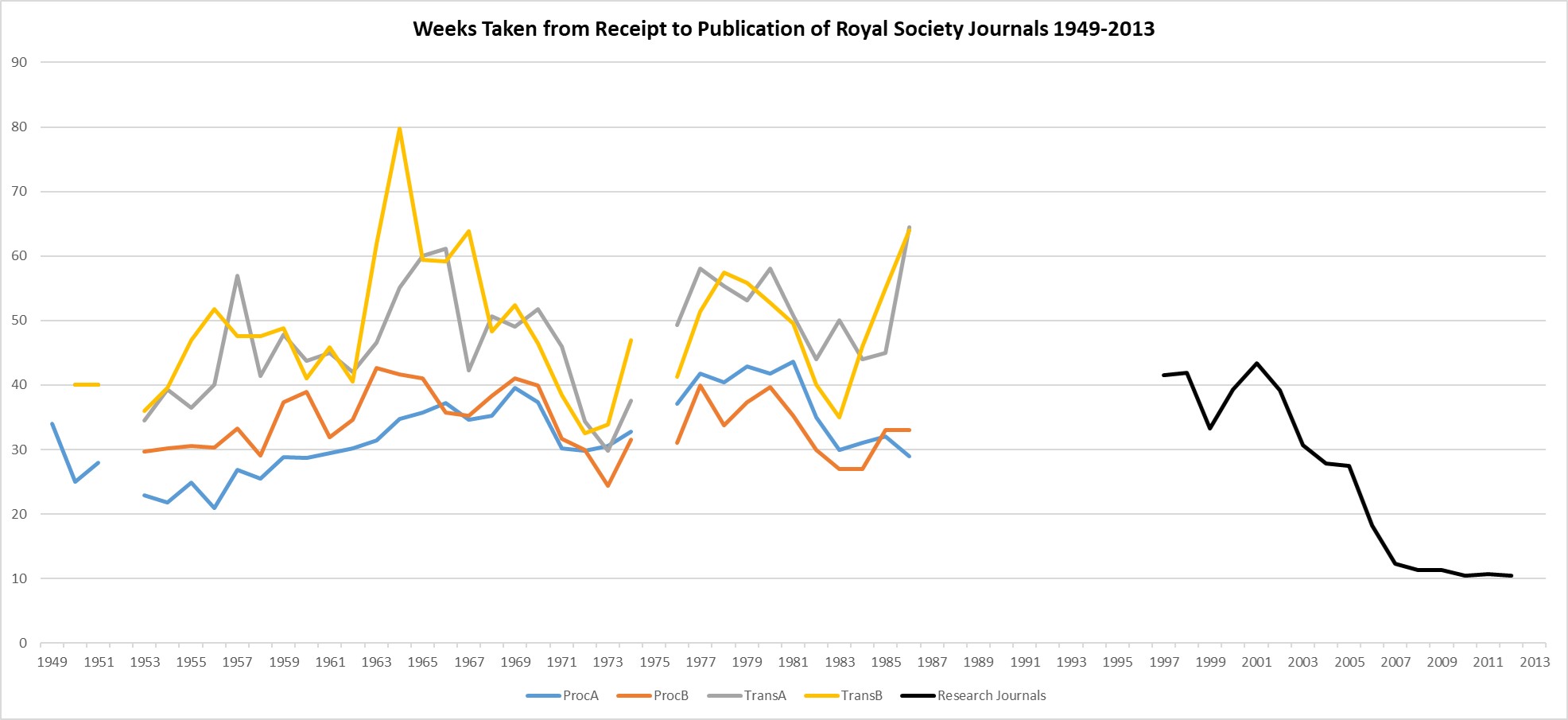How has the average length of a scientific article changed over time? The answer depends on the purpose of the ‘article’ (a letter, a preliminary announcement, a fully-detailed research monograph); the space available in the printed journals; and the contemporary fashion for scholarly writing. But here, nonetheless, are some insights from the history of Royal Society publishing. Continue reading “Length of articles in Royal Society journals”
The Royal Society’s ‘other’ journals
The Proceedings and the Philosophical Transactions may have been the Royal Society’s best-known periodicals in the twentieth century, but they were not its only ones. It also published (and publishes) a number of periodicals aimed largely at an internal audience of Royal Society fellows. Here is what we know about their circulations. Continue reading “The Royal Society’s ‘other’ journals”
Time Taken to Publish
The time taken from receipt of a submission to publication is today frequently used as a ‘key performance indicator’ by academic journals. It is a (partial) measure of the speed or efficiency of the journal’s editorial and production processes (though also highly dependent on the author’s approach to revisions and proofs). The Royal Society has been recording and reporting this metric since the early 1950s, which allows us to produce the graph below:
The Proceedings in the 20th Century
The Proceedings of the Royal Society has been printed since early 1831, when it reported the activities (or ‘proceedings’) of the weekly meetings of the Royal Society. The first meeting reported was that for November 1830. For the rest of the nineteenth century, it carried a mix of content: reports of meetings; annual accounts; summaries of papers presented to meetings of the Societies (similar to abstracts); short stand-alone papers; and occasional longer papers full of data, deemed insufficiently ‘significant’ for publication in the Transactions.
Here, we present some overviews of the twentieth-century Proceedings.
Rejection rates in life sciences vs physical sciences, 1950s-1980s

This graph offers additional detail on the overall rejection rates at the Royal Society’s Transactions and Proceedings in the second half of the twentieth century. As I discussed in that earlier post, the Royal Society historically had a low rejection rate (around 10-15%), due to the filtering-out of papers that was done pre-submission, since papers had to be submitted via a fellow. Continue reading “Rejection rates in life sciences vs physical sciences, 1950s-1980s”
More submissions, more rejections: the Royal Society Journals since the 1950s
I looked at the numbers of submissions to the Royal Society journals in an earlier post. Here, we look at the relationship between the number of submissions, the rejection rate and the sustainability of peer review. Continue reading “More submissions, more rejections: the Royal Society Journals since the 1950s”
Quality in peer review: a view through the lens of time
The Royal Society has been asking for expert advice on papers submitted for publication since the 1830s, and quality (or something like it) has always been one of the elements under consideration. Here, I investigate how the definition of ‘quality in peer review’ has changed over time.
Continue reading “Quality in peer review: a view through the lens of time”
What the history of copyright in academic publishing tells us about Open Research
The protections offered by copyright have enabled authors – and their publishers – to make a living from their works since the first copyright act, for ‘the Encouragement of Learning’, was passed in 1710.
Academic authors, however, do not depend upon copyright for their livelihoods. Instead, for many researchers, copyright has come to seem like a tool used by publishers to pursue commercial, rather than scientific interests. Notably, open access advocates have long argued for changes to the ways researchers use copyright, a position that has recently found support in Plan S’ mandate for the use of Creative Commons licences as an alternative.
Continue reading “What the history of copyright in academic publishing tells us about Open Research”
Then and now – exploring diversity in peer review at the Royal Society
This piece on the history of peer review at the Royal Society and the problem of unconscious bias originally appeared on the RS Publishing Blog, 10 Sept. 2018, as part of Peer Review Week 2018.
Peer review cannot be done by everyone. It can only be done by people who share certain levels of training and subject-expertise, and have a shared sense of what rigorous experimentation, observation and analysis should look like. That shared expertise and understanding is what should enable alert peer reviewers to reject shoddy experimental methods, flawed analysis and plans for perpetual motion machines.
But as we have increasingly come to realise, any group of people with shared characteristics may display unconscious bias against outsiders, whether that means women, ethnic minorities, or those with unusual methods. While peer review should exclude poor science, it should not exclude good research on the basis of the individual traits or institutional affiliation of the researchers, nor should it dismiss innovative approaches to old problems.
However, it seems socio-cultural and intellectual criteria have often been mixed together in the peer review process, and history can help us to understand why.
Continue reading “Then and now – exploring diversity in peer review at the Royal Society”
Ownership and control of scientific journals: the view from 1963
On 13 June 1963, the president of the Royal Society Howard Florey presented a ‘Code for the Publication of New Scientific Journals’ to a meeting of officers representing 55 British scientific societies.
In the light of subsequent developments in the management and ownership of scientific journals, the Code’s insistence upon scholarly control of academic journals is notable. It was written at a time when the growing involvement of commercial publishers in academic publishing was becoming visible.
“The present tendency for commercial publishers to initiate new scientific journals in great numbers is causing concern to many people. With the expansion of established sciences and advances into new fields and disciplines it is evident that new journals are necessary.”
Continue reading “Ownership and control of scientific journals: the view from 1963”

